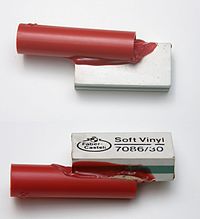
Photo from wikipedia
The work deals with the application of biopolymer fillers in rubber formulations. Calcium lignosulfonate was incorporated into styrene–butadiene rubber and acrylonitrile–butadiene rubber in a constant amount of 30 phr. Glycerol… Click to show full abstract
The work deals with the application of biopolymer fillers in rubber formulations. Calcium lignosulfonate was incorporated into styrene–butadiene rubber and acrylonitrile–butadiene rubber in a constant amount of 30 phr. Glycerol in a concentration scale ranging from 5 to 20 phr was used as a plasticizer for rubber formulations. For the cross-linking of the compounds, a sulfur-based curing system was used. The study was focused on the investigation of glycerol in the curing process; the viscosity of rubber compounds; and the cross-link density, morphology, physical–mechanical, and dynamic mechanical properties of vulcanizates. The study revealed that the application of glycerol as a plasticizer resulted in a reduction in the rubber compounds’ viscosity and contributed to the better dispersion and distribution of the filler within the rubber matrices. The mutual adhesion and compatibility between the filler and the rubber matrices were improved, which resulted in the significant enhancement of tensile characteristics. The main output of the work is the knowledge that the improvement of the physical–mechanical properties of biopolymer-filled vulcanizates can be easily obtained via the simple addition of a very cheap and environmentally friendly plasticizer into rubber compounds during their processing without additional treatments or procedures. The enhancement of the physical–mechanical properties of rubber compounds filled with biopolymers might contribute to the broadening of their potential applications. Moreover, the price of the final rubber articles could be reduced, and more pronounced ecological aspects could also be emphasized.
Journal Title: Materials
Year Published: 2023
Link to full text (if available)
Share on Social Media: Sign Up to like & get
recommendations!